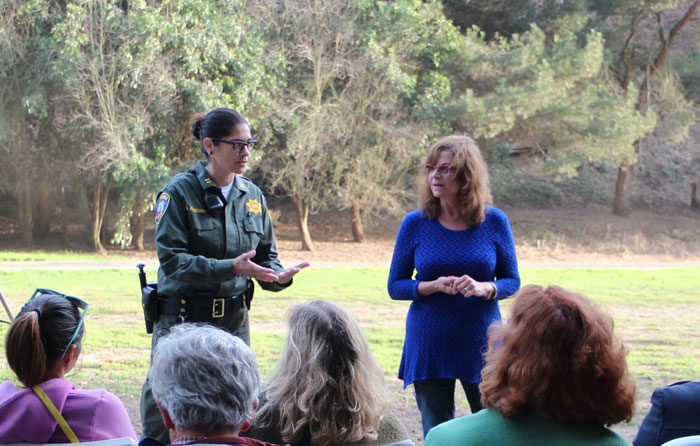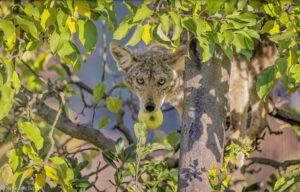On a recent Wednesday evening at the edge of Pine Lake Park dog play area in San Francisco, Gina Farr stepped forward in front of several dozen people and their dogs, and rattled a Red Bull can full of loose change in the face of a volunteer. “And then I say, ‘Go away coyote! Go away!’” she shouted.
Farr, a coyote educator and communications advisor at Project Coyote, was leading a lesson in “coyote hazing” as part of a class about co-existing with wildlife in the city. Project Coyote, which partners with San Francisco Animal Care and Control, will lead a larger public meeting about coyote interactions at the Lake Merced Boathouse on Thursday, Oct. 22.
The gathering at Pine Lake Park followed a summer that saw two small dogs attacked by coyotes there in separate incidents a month apart. Heavy media coverage of the attacks, in which one dog was killed, have helped stir up fear and frustration among people — including many at the hazing workshop — who are worried about what they perceive as a growing number of increasingly bold city coyotes.
The public instruction to use hazing techniques — such as raising arms and shouting — to keep coyotes from getting too comfortable around people and pets is something of a shift for the city, which emphasizes coexistence with a predator that also brings significant ecological benefits to urban areas.

Coyotes have been reported in parks in San Francisco for nearly 15 years, and wildlife experts say it’s the same story in virtually every North American city.
“They’re attracted to the resources that we provide so abundantly: food, water and shelter,” Farr said. As true omnivores, coyotes favor rodents but can live on roots, fruits, carrion, and the contents of your trashcan. San Francisco’s varied topography and wild parks offer plenty of cover to the naturally retiring canids; while they may venture out in the daytime and at times appear unfazed by people, they avoid human confrontation. “Nuisance behavior” like lingering in yards or refusing to stand down is rare, Farr said, and people are usually to blame: A coyote may lose its natural fear if it’s fed intentionally or learns it can get an easy meal from an unsecured garbage bin.
Peoples’ pets are a different story. Coyotes, which live in complex social groups, may see larger dogs as competition, Farr said. They may see smaller ones as prey, especially when they’re running off-leash, which can lead to confrontations like the ones at Stern Grove.
But whether the two attacks there indicate that the city’s coyote population is growing bigger and bolder is an open question. In fact, there’s very little hard data on San Francisco coyotes. The city’s Animal Care and Control website asks residents to report coyote sightings via e-mail, but department spokeswoman Deb Campbell said only major incidents—those that require field visits, like a coyote attacking a pet or getting hit by a car—are documented by staff. “We just look for patterns,” she said. “We’re not wildlife experts. We don’t collect that information.”
“There are so many options and opportunities to live well with urban wildlife,” Farr said. “We can’t do nothing, and we can’t expect others to do something for us.”
Other cities with thriving coyote populations do more. Wildlife biologist Stanley Gehrt leads the world’s longest-running urban coyote study in Chicago and surrounding Cook County, where more than 400 animals have been outfitted with radio collars since a research effort began 15 years ago. Gehrt said Chicago’s animal control agents fill out forms whenever they get coyote-related calls. Austin and the Denver suburbs of Broomfield and Aurora have similar policies. Some cities even update publicly available maps of sightings, Gehrt said.
Such an approach allows city officials to reassure residents when coyotes are acting normally, said Gehrt, and respond effectively if they’re not.
“They can kind of determine whether people are reporting the same kind of behavior, or whether there’s a change that’s taking place,” he said. “If they get repeated complaints and they’re localized, then that’s something they could take a closer look at.”
That level of municipal monitoring typically is prompted by some kind of coyote-related conflict, such as a string of attacks on pets, he said.
“Rarely do they do this before they have to,” Gehrt said.
An uptick in sightings doesn’t necessarily mean a population boom is underway, said Janet Kessler, who has been observing San Francisco’s coyotes for decades. While it’s possible that numbers are going up here, she said she hasn’t seen a dramatic increase, but has watched different family groups that claim territories in the city’s parks and open spaces fluctuate between two and five individuals over the last seven years.
There are definitely more people and pets here, she said, which increases the likelihood of coyote interactions. Social media makes it easy to share reports of those encounters, which boosts public perception of the animals’ presence.
“People are seeing more, and they’re spreading the word more,” Kessler said, but she added she doesn’t think keeping closer tabs on coyotes is necessary. Their populations are largely regulated by the resources available to them, she said. Human city-dwellers just need to learn to live with them. “It shouldn’t be a scary thing,” she said.
Kessler and Farr agreed on some basic guidelines: keep dogs on leashes when in parks; avoid parks at dawn and dusk when coyotes are likely to be most active; and be ready to shout down a coyote if you do come face-to-face with one.
“There are so many options and opportunities to live well with urban wildlife,” Farr said. “We can’t do nothing, and we can’t expect others to do something for us.”
Lisa Vittori, one of the dog owners who attended the hazing training, said it’s not always so simple. She’s lived in the city for decades, and said she’s watched the coyote issue fan passions among dog lovers, environmentalists, and animal welfare activists.
“People have a lot of primal fears around wild animals,” she said. “We all want them around until they start to bother us.”





